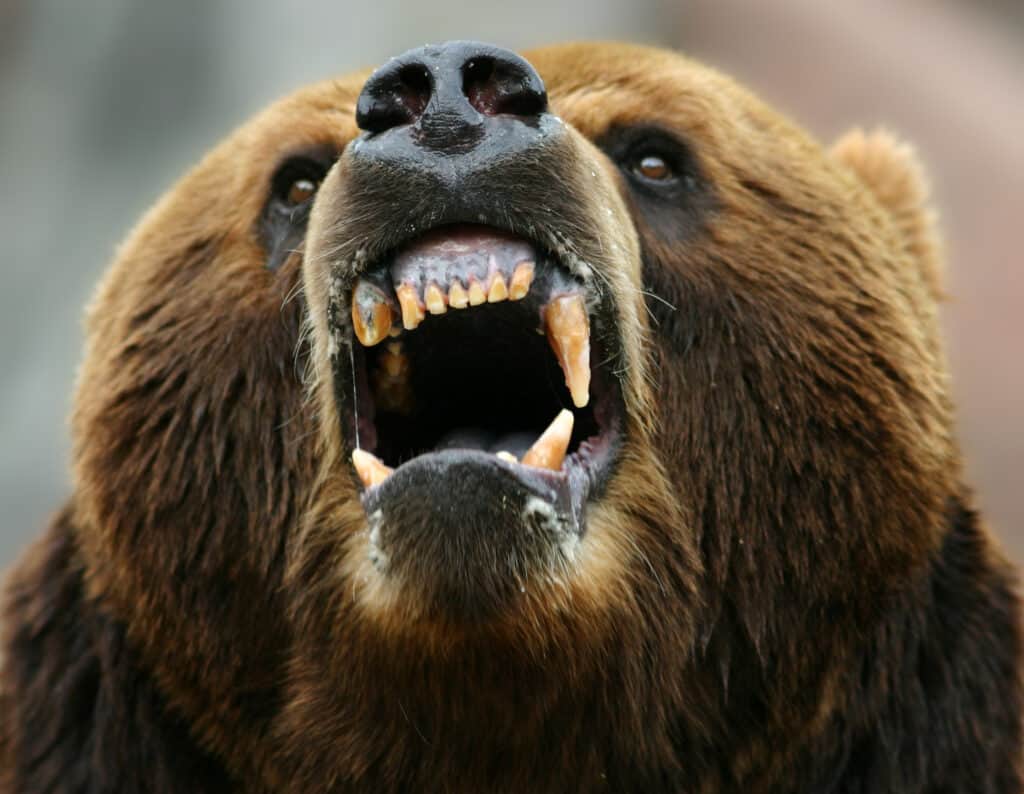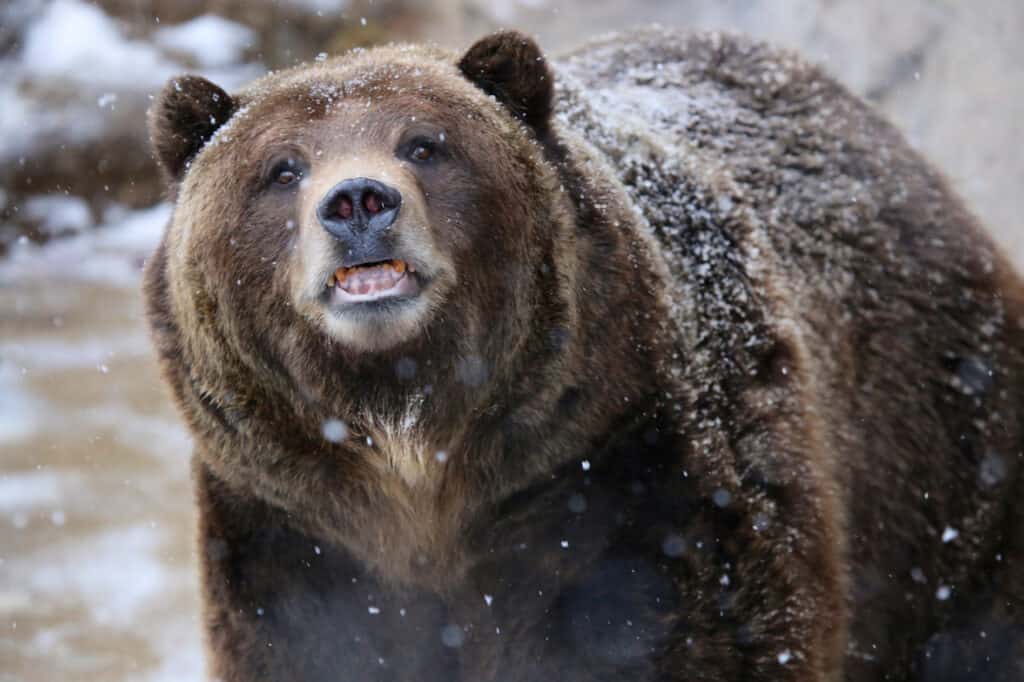The grizzly bear is an important part of the popular mythology of the American West and the Rocky Mountain region. Named after the parts white or gray tips of the hair, it is among the largest land predators in the world.
When it comes to brown bear vs grizzly bear, many people may not know that the grizzly bear is not a separate species at all. It’s actually a subspecies of the brown bear, which occurs all over the world. Other common subspecies include the Eurasian brown bear, the Kodiak bear, and the Syrian brown bear.
To understand brown bear vs grizzly bear, it’s necessary to define exactly what a subspecies is. Animals which belong to different subspecies are capable of breeding with other members of their species in spite of the distinct features unique to each group.
If you brought a grizzly bear and a Eurasian brown bear together, they would still probably be able to mate with each other. But because their different ranges prevent them from mating in the wild, there’s very little gene flow between them, and they begin to develop unique physical and behavioral characteristics, distinctive to each one.
This is the key to understanding brown bear vs grizzly bear.
Comparing the Grizzly Bear vs Brown Bear

The range of grizzlies is rather restricted compared to the range of the Eurasian cousins
©Karin Jaehne/Shutterstock.com
Here’s a quick breakdown of the main similarities and differences between the grizzly bear and the other brown bears.
| Brown Bear | Grizzly Bear | |
|---|---|---|
| Length | 3 to 10 feet (1 to 3 m) | 5 to 8 feet (1.5 to 2.4 m) |
| Weight | 176 to 1,700 lbs. (80 to 771 kg) | 200 to 900 lbs. (91 to 408 kg) |
| Distribution | Northern Hemisphere | Pacific Northwest region of North America |
| Fur Color | Light to dark brown | Brown base color with silver or pale tips |
| Body Shape | Muscular body, thick mane on the neck, curved claws, and big hump | Dished face and short ears, also with a muscular body and hump |
The 4 Key Differences between Grizzly Bear vs Brown Bear

Both grizzlies and brown bears are capable of growing to similar sizes
©PhotoBarmaley/Shutterstock.com
The differences between the grizzly vs brown bear are quite subtle. But if you know what to look for, then it should be possible to distinguish them, even from a safe distance. As humans move into previously wild areas and the climate changes, bears are forced to move into new territories.
As a result, previously separated sub-species are coming into contact with each other and mate and produce offspring. As a result, the lines between the grizzly vs brown bear are becoming less distinct. There are also a growing number of matings between Polar Bears and Grizzly Bears.
The resulting offspring are known as grolar bears. They can also be called pizzly bears, zebra bears, and grizzlar bears. Additionally, a ghost bear is known as a Spirit bear or a Kerode bear and is a subspecies of the American black bear.
Grizzly Bear vs Brown Bear: Location
The easiest way to distinguish the grizzly vs brown bear is their physical location. While the brown bear is found all across the Northern Hemisphere (especially Europe, the Asian steppes, and parts of the Middle East), the grizzly bear is specifically unique to North America – though because of hunting and habitat loss, its range is now mostly restricted to the northwestern part of the continent.
What complicates matters even further is that some experts recognize several North American subspecies, while others recognize only two, the grizzly bear and the Kodiak bear of southern Alaska. Either way, if you see a brown bear in the northwestern Pacific region, it’s almost certainly a grizzly. The other North American subspecies have very limited geographical ranges.
Grizzly Bear vs Brown Bear: Physical Size
The grizzly bear has a wide range of different sizes. It tops out at an impressive 8 feet and around 900 pounds, but some individuals are only about 5 feet long and weigh a few hundred pounds. Coastal grizzlies are generally much larger than inland grizzlies, and males are much larger than females.
While this size may seem impressive, it cannot quite compare to the massive size of the Kodiak bear, widely regarded as the largest living land carnivore in the world, which can reach up to 10 feet long and an astonishing 1,700 pounds. A grizzly is about the same size as the Eurasian brown bear though.
Brown Bear vs Grizzly Bear: Fur Color
When looking at the coloring of the grizzly vs brown bear, the grizzly bear features a brown to buff fur color (sometimes appearing almost white) with silver or pale tips, especially around the back and shoulders. Most other types of brown bears have a more standard brown appearance.
The brown bear has fur that ranges from a cream or silver color to almost black. Grizzlies have fur that is highlighted with a lighter color than the rest of its fur. This gives the fur a knarled look and is how grizzlies got their names.
Brown Bear vs Grizzly Bear: Morphology
The grizzly bear is characterized by a dished facial profile, long claws, short and rounded ears, and a particularly prominent shoulder hump. A dished face essentially means it has a concave shape; it curves strongly inward at the snout. Many other types of brown bears have a slightly flatter facial profile.
Brown Bear vs Grizzly Bear: Other Differences That Exist Between Them

Eurasian brown bears are capable of living slightly longer compared to grizzlies
©Steve Boice/Shutterstock.com
First is the issue of lifespan. Here both bears are pretty similarly matched in terms of the minimum number of years they can expect to live for: 20. However, things change when it gets to the maximum, and Eurasians, slightly edge out their kin on the other side of the globe since they can get to live for three decades at the most. Grizzlies on the other hand can only expect to live for a maximum of 25 years in the wild.
What about sheer strength? We know that grizzlies have a bite force of 1160 psi, pretty close to the polar bears of 1200 psi. Yet, not much is known about how powerful the jaws of Eurasian brown bears are.
However since both bears generally grow to similar sizes, it is safe to assume they are likely to be equally matched, in terms of strength. Unless, of course, a Kodiac bear enters the picture.
Is the Kodiak Bear Also a Brown Bear?
So what about the Kodiak bear? We’ve mentioned it a couple of times in this article, so let’s clarify the relationship.
The Kodiak bear is also a subspecies of the brown bear (Ursus arctos middendorffi) just as the grizzly is a brown bear subspecies. However, the Kodiak bear lives only on the islands of the Kodiak Archipelago, which is a group of barrier islands south of Alaska in the Gulf of Alaska, about 250 miles southwest of Anchorage. The archipelago is 177 miles long and 67 miles wide. Its largest island, Kodiak Island, is the second-largest island in the United States, so there is plenty of room for large bears. Also, after being isolated from other bears for over 12,000 years, it is easy to see how the Kodiak became its own type of bear.
This subspecies is the largest bear in the world. A Kodiak male can grow to 10 feet tall on hind legs, or 5 feet tall on all fours, and it can weigh up to 1,500 pounds. While it is considered the largest land-based carnivore, it is actually an omnivore that eats more plant food than meat. Fortunately, the 3,500 Kodiak bears have a healthy environment and are carefully monitored by wildlife officials.
The photo featured at the top of this post is ©
FAQs (Frequently Asked Questions)
What's the difference between a brown bear and a grizzly?
The grizzly bear can be distinguished by the dished (concave) face, the medium to large size, and the silver or pale tips of the fur. It is one of the few recognized subspecies of brown bears, besides the Kodiak bear, to inhabit North America.
What is more dangerous, a grizzly bear or other brown bears?
Despite the enormous size, neither one is likely to attack a person unless it feels threatened in some way. When attacks do occur, they’re often a result of a mother protecting her cubs. What many people may not know is that brown bears, despite being predatory in nature, mostly like to eat vegetable matter. The long claws and muscular body help them dig up roots and bulbs. When they do eat meat, it’s usually fish. Nevertheless, if you encounter a bear in the wild, it is not a good idea to disturb it.
What is the difference between a grizzly bear and a Kodiak bear?
The Kodiak bear is another subspecies of the brown bear. It is endemic to the Kodiak Archipelago in southern Alaska and generally doesn’t overlap too much with the grizzly. Even if you didn’t know their location, you could still probably distinguish them from their massive size. Weighing up to 1,700 pounds, the Kodiak bear is considered to be the largest land predators on the planet.
Why are coastal brown bears larger than inland bears?
Experts believe it’s because of a diet high in salmon. At one point, people considered the coastal grizzly to be a separate subspecies from the interior “true” grizzly. Because of the large difference in size, it’s easy to make that mistake. But this coastal/inland size difference actually occurs all over the world with every type of brown bear. It does not appear to be caused by genetic factors.
Thank you for reading! Have some feedback for us? Contact the AZ Animals editorial team.







